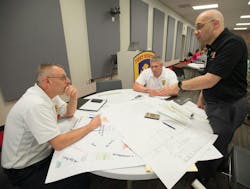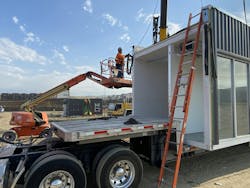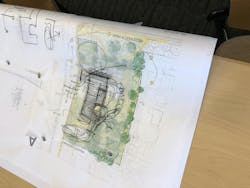Note: This article is part of the Firehouse 2025 Station Design Supplement. To read the entire supplement, click here.
Many fire departments across the United States are doing an excellent job building stations to meet today’s challenges, but are those facilities ready for tomorrow? Given that a new firehouse can have a life expectancy of 50 years or more, have departments considered design elements that will keep their station(s) effective in 2075? Evolving technologies, particularly artificial intelligence (AI) and quantum computing, will transform department operations. Additionally, limited building space, lithium-ion battery storage, electric/hybrid apparatus, unmanned aerial systems and urban growth are among the factors that must be addressed in future stations. Of course, every challenge for the next 50 years can’t be predicted. Nevertheless, key considerations should be implemented today to prepare the fire service for tomorrow.
Electric/hybrid rig infrastructure
Myriad communities are calling for environmentally friendly fire departments, and regulations on diesel engines are pushing the fire service toward electric vehicles (EVs) and hybrid vehicles. As apparatus manufacturers ramp up production, stations must accommodate these advancements.
Future stations will need high-voltage, high-amperage charging stations. Although the power that’s provided by traditional shorelines works for chargers for radios and thermal imagers, EVs require more power. (Departments even should consider installing personal vehicle charging stations for personnel.) Preplanning these elements can prevent costly retrofits and service disruptions. Additionally, backup generators must be capable of supporting increased electrical demands.
Charging infrastructure comes in three primary levels today:
- Level 1 (120V, 1.3–2.4 kW, requires days to charge an EV).
- Level 2 (240V, 3.0–19.2 kW, requires 6–12 hours).
- Level 3, aka fast-charging (typically 480V, 50–400 kW, requires 20–40 minutes).
Emerging ultra-fast and wireless induction chargers also are being evaluated.
As EV technology evolves, designing adaptable electrical infrastructure and ensuring that the available power will handle future demands are critical.
Li-ion battery charging
As more battery-powered equipment replaces traditional tools, stations must store and charge lithium-ion (li-ion) batteries safely. Battery-powered PPV fans, extrication tools and saws offer comparable performance to their small-engine counterparts, are lighter in weight and require less overall maintenance, but li-ion batteries have a high failure rate during charging.
The increased frequency of battery-failure incidents in the public sector and the extensive damage that they caused coincide with increased use of battery-powered equipment because of advancements in technology. Stations must include investment in fireproof charging solutions.
To mitigate fire risks, stations should incorporate dedicated charging rooms that have additional fire-rated protection, fireproof storage cabinets, dry powder extinguishers and structural separation. In multistory stations, ideally, these rooms aren’t located beneath crew quarters. Implementing ventilation systems and temperature monitoring can add an extra layer of protection in relation to thermal runaway, which is a significant risk with li-ion batteries and the uncontrollable fires and explosions that can result.
Green space & expansion
Because the U.S. population is expected to grow by 22 million in the next 39 years, primarily in urban and suburban areas, a station that’s built today must be adaptable to serve the needs of tomorrow’s community effectively. However, densification and diminishing green space pose challenges for constructing new fire stations. A modern station requires at least an acre for pull-through bays, turn radii and parking. Future expansion should be a key consideration in station planning.
One strategic approach in a station design project is to purchase a larger plot of land than what minimally might be needed, to allow for station replacement without disrupting services. Alternatively, departments can acquire two properties, one as a city park and the other as a station. When the station requires replacement, the park can be converted into a new station, and the old station site can become a park. This option has the benefit of adding a city park to the community’s services as well as not disrupting department responses during the building phase.
Where additional land is unavailable, modular design concepts can facilitate future expansion. Off-site prefabricated station sections can be delivered and assembled in phases, which ensures continuity of service.
Another option is designing stations in planned phases, which allows for the addition of bays and/or bunkrooms as needed. Phase 1 would be the immediate need. Phase 2 and beyond account for future growth. In most of these designs, like the modular design, the two primary areas that must grow to accommodate additional crews and apparatus are on the exterior portion of the building, which would allow a future chief to add additional bays or bunkrooms.
This forward-thinking approach reduces future costs and minimizes service interruptions.
The cost of land acquisition is rising, which makes strategic investments in future sites even more critical. Departments should explore partnerships with municipalities and developers to secure land before urban expansion limits availability. Considering vertical expansion, such as multistory designs, also can be a viable solution for space constraints.
Planning for new tech upgrades
Retrofitting technology into an existing station is costly and complicated. One department’s recent station alerting upgrade revealed that conduit installation alone accounted for nearly one-third of the project’s cost. Installing these systems in a new build is significantly less expensive because of preplanned infrastructure.
To future-proof stations, departments should consult IT professionals, who will install, maintain and, eventually, upgrade equipment, to ensure adequate space, ventilation and cooling for servers, battery backup systems and advanced audio-visual equipment. It’s always worthwhile to increase the conduit size or add additional conduits for future needs before the walls are sealed. Adding extra square footage for IT infrastructure also simplifies future upgrades while improving access for maintenance.
Advancements in automation and smart building technology are poised to revolutionize fire station management. Integrating intelligent lighting and climate control and automated alerting systems can enhance efficiency and reduce energy consumption.
Forward-thinking departments should evaluate the role of AI in the design of new stations. This should include AI-driven dispatch systems that optimize response times.
Forecasted vs. historical
Collectively, the fire service has gotten better about using data to assist decisions, but moving beyond historical data is key to successfully building a station for tomorrow. By the time that historical data identify a gap in service that might warrant another station, the construction process puts a department behind the proverbial eight ball but also puts a community at risk.
Advanced data analytics is another trend to monitor; it’s starting to forecast the future of emergency response requirements. Even if a department believes that forecasting in this manner seems way beyond its current capabilities, establishing actionable metrics on usage, simultaneous calls for service or calls for service of a certain nature or type can assist in deciding where future stations should be located. Hopefully, more communities throughout the United States are beginning to adopt master plans for future development, but even in the case of those that aren’t doing that, myriad departments are finding value in
the form of coming to the table early with developers to discuss adding stations to large community projects. Adding 1,000 homes in an area must consider the future residents and their needs.
As densification continues across nearly every jurisdiction, departments shouldn’t forget to re-evaluate the needs within historic or stable areas. It’s becoming increasingly common to knock down a few homes to build apartments and, even worse, to knock down a few apartments to build a megaplex.
In the end, successful fire and emergency services leaders must think strategically with the data at hand to stay ahead of the community’s needs.
Sensible time investment
Fire and emergency services leaders face complex decisions daily, many of which are shaped by the foresight (or lack thereof) of their predecessors. The question that every leader must ask is: How do I want to be remembered in 25 to 50 years?
Will today’s decisions create challenges for future chiefs, or will careful planning ensure a lasting, effective fire station? Whether considering technology upgrades, expansion potential or optimal station placement, investing time in future-proofing stations today is crucial for long-term community safety and service effectiveness. Thoughtful planning today will set the foundation for a fire service that can adapt, grow and thrive in an ever-changing landscape.
Drone Pads
Unmanned aerial systems (UASs) have evolved from toys to valuable tools in the fire service arsenal. From the wildland urban interface to the modern warehouse fire, these tools have been improving fire department effectiveness and the safety of communities.
Several departments implemented Drone as a First Responder (DFR) into their operations. DFR allows a UAS to be deployed at the first 9-1-1 call, which provides a video feed of the incident well before the first unit arrives.
UASs also have been deployed to deliver lifesaving equipment and medications well before the arrival of first responders. Currently, an even more advanced concept is being evaluated: manned aerial systems. Soon, fire departments will be capable of dispatching a manned drone to an address, to provide advanced lifesaving measures, and transport a patient to the hospital completely on a flying platform.
To increase the effectiveness and efficiency of DFR, launch pads on the roofs of city buildings are imperative. Design elements that permit access to the roof for maintenance of UASs and electrical infrastructure to support the charging of the large battery systems should be considered.
About the Author

Jason Moore
Jason Moore is a 23-year veteran of the fire service who began his career with the U.S. Air Force as a fire protection specialist. Moore is involved with the International Association of Fire Chiefs’ Technology Council and is a founding member/associate director of the Indiana University Crisis Technologies Innovation Lab. He delivered presentations on implementing technology, using technology for community risk reduction and best practices to justify funding for innovative programs. Moore was the keynote speaker at FireFusion 2024.

Scott Roseberry
Scott Roseberry is a battalion chief with the Garland, TX, Fire Department who has more than 25 years of experience in the fire service. He has a bachelor’s degree in emergency management and a master’s degree in public administration. Roseberry holds the designations of Executive Fire Officer, Certified Public Manager, Chief Fire Officer, Fire Service Chief Executive Officer and Chief Fire Executive. He is the chairperson of the International Association of Fire Chiefs (IAFC) Technology Council and a member of the FEMA Region 6 Regional Advisory Council and serves on the Department of Homeland Security First Responder Resource Group. Roseberry is a frequent presenter at the IAFC’s Fire-Rescue International and Technology Summit International. He has commanded many multi-alarm assignments, including a devastating EF-4 tornado response.


